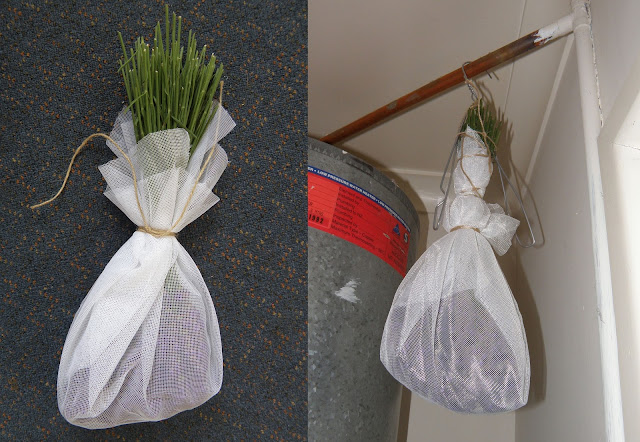 |
| Zesting |
After Caroline left, I still had a large number of picked lemons remaining that needed to be dealt with quickly. So Wednesday morning, I continued juicing them to freeze for future use. Following suggestions on the Internet, I discovered that the easiest way to remove the zest is to use a vegetable peeler. You can then cut the pieces of skin into strips with a sharp knife or mezzaluna.
I am going to dry this batch of zest to use in bath salts, so I spread out the zest in a large glass pan and then pressed down paper towel to soak up the excess juice. After leaving the zest like this overnight, I think transferred to it to a drying frame (an old picture frame with net attached that I used for paper-making once), covered it with another layer of netting and then hung it up in my hot water cupboard.
 |
| Drying the zest |
I
 |
| Haul no.2 and still heaps to go! |
finally came to the end of the lemons, having put over a litre and a bit of the juice in the freezer, when a friend popped round to help me harvest some more. Just in time too. Soon after we got them rinsed off and moved onto the deck, the weather packed in, bringing with it rain and wind. And so, I finished the day with another huge haul to deal with. Back to square one, sigh!
Thursday morning, the worst of the storm had passed and we were treated to another spectacular rainbow. The dawning of another day of the age of lemons.
 |
| A lemon dawn |
Lesson learned:
Line the tin with paper as once the syrup has soaked in, the loaf is impossible to get out!
It might also have helped to let the loaf cool down properly, but I was impatient and hungry to get a taste of my baking and in my haste to get the luscious loaf out of the pan it split, leaving the bottom in the pan which I had to scrape out. Sigh! Of well, it certainly tasted good and as I had baked it for myself, it didn't matter.
I continued juicing lemons, but I must admit, I was starting to get a bit jaded of the process. I tried a shortcut of blitzing the whole zested/skinned lemons, plus a small amount of skin in my blender and then sieving the pulp. I figured that since many recipes call for zest and juice, why not simply chuck in the whole fruit. Besides, store-bought orange juice is made the same way, the entire fruit – skin and all – is squeezed, which is why it's so sour and bitter even though the fruit is so sweet.
It worked well and produced that same sour tang to the juice that you get in squeezed orange juice. I think it will work well for my lemon cordial where one wants a tangy sharpness to the drink, but not for my lemon jelly where sweetness is the aim.
 |
| Juicing for cordial |
 |
| Trixie: Operations supervisor, office paper shredder and nap specialist |
Another two milk bottles full of juice later, and still a huge number of lemons to go, I packed it in for the day. Like my blender, I work best in short bursts! Time to follow Trixie's example and have a nap.
































